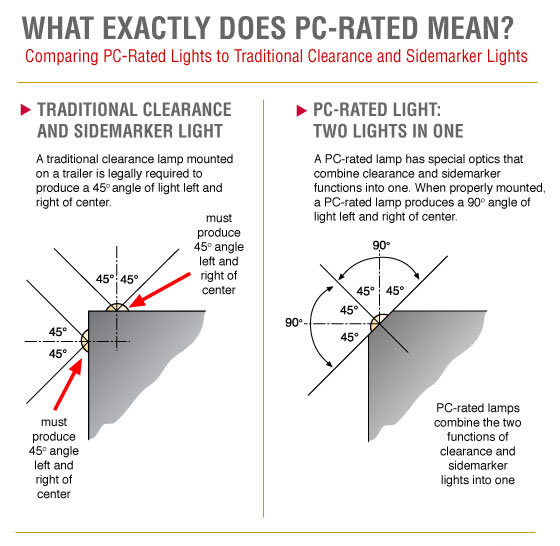The SAE J759 Lighting Identification Code can be difficult to interpret regarding clearance and marker applications. This additional information may be helpful.
P2: Clearance Sidemarker and Identification Lamps
This marking is currently used for both “over” 80 inch and “under” 80 inch vehicles. It has become the standard for vehicles under 80 inches, but government specifications (FMVSS-108) have never called out increased requirements for the smaller width. P2 is the minimum standard for clearance, sidemarker or identification lights. All Truck-Lite devices meet this standard, even if they are marked PC, P3, etc.
PC: Combination Marker and Clearance or Identification for vehicles over 80 inches wide
To be used as a “combination” light, devices must be mounted on a 45° bevel at the corner of a vehicle. This allows Clearance and Marker functions to be “combined” in one light, and eliminates the need for a second device. A PC light can always be used anywhere a P2 light would have been used, but the reverse is not true.
P3: Clearance, Sidemarker or Identification lights for use on vehicles over 80 inches wide
A P3 designated lamp has wider light outputs than a P2 rated lamp. It is legal wherever a P2 light would be used. Because the federal regulations (FMVSS-108) has yet to adopt P3, many manufacturers have not made lights to meet the standard. Some of Truck-Lite’s lamps do not meet this standard, and are marked accordingly.
PC2: Combination Marker and Clearance or Identification lights used on a vehicle over 80 inches wide
PC2 Lamps meet an increased angle output, and are designed as combination lamps. When used as combination lamps, they must be mounted on a 45° beveled corner. Because the federal regulations (FMVSS-108) have yet to adopt P3, many manufacturers have not made lights to meet the standard. Some of BTW’s lamps do not meet this standard, and are marked accordingly.
Additional Points of Concern:
- Currently, the FMVSS-108 standard has recognized only the standards that call for P2 or PC markings. The other markings are for “optional” SAE standards.
- The PC or PC2 lights offer the widest patterns of visibility.
- FMVSS-108 does not require any of these lens markings, with the exception that they accept “DOT” lettering as certifying legal compliance
- NHTSA and Transport Canada are in the process of rewriting FMVSS-108. It is not known if the “new” version will recognize PC2 or P3 markings. If they are recognized, it is certain that there will be a several-year phase-in of the requirements.
The legal requirements for trailer lights can be grouped into two classes: trailers less than 80″ wide, and those that are more than 80″ wide. Trailers less than 80″ wide are required to have tail lights, stop lights, turn signals, side marker lights and side and rear reflectors on each side. You must also have a license plate light and, on trailers over certain lengths, additional side marker lights and side reflectors are necessary.
Trailers over 80″ wide need a few additional lights to help define the perimeter of the trailer. At the rear of the trailer three red identification lights are required and are usually sold as a single bar with the lights mounted at the required spacing (similar to the tops of tractor-trailer rigs and the rear of their trailers). Clearance lights, intended to alert drivers to the width of your trailer, are required on each side and should be placed as far outboard as possible (generally on the trailer fenders).

